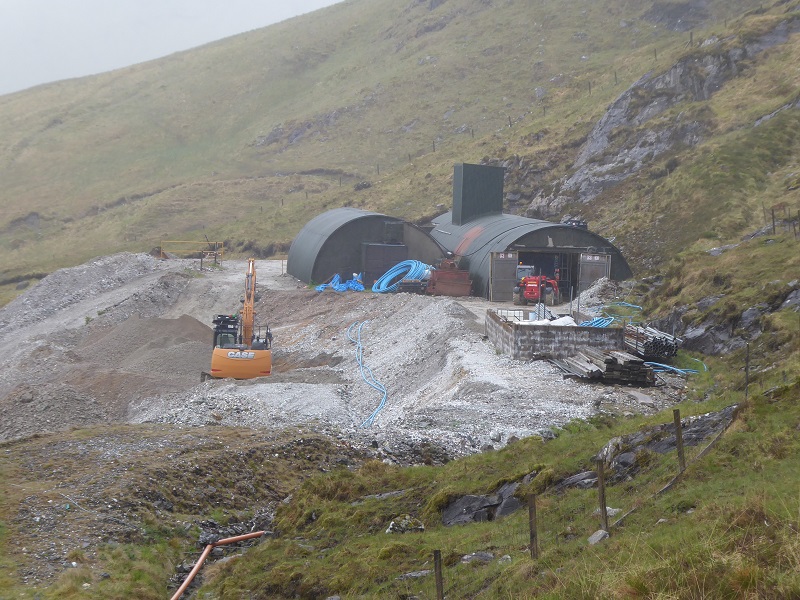
The failures in the Loch Lomond and Trossachs National Park’s consultation system
A couple of weeks ago, at the Scottish Wild Group AGM, I was told that a planning application had been submitted back in August for the new proposal for waste storage waste from the Cononish Gold Mine (see here). The formal consultation period lasted 28 days and, while I have spent a few days feeling bad that I had missed this and failed to advertise what is being proposed, what I have realised is very few other people knew about the application either. That is until Scotgold placed a story in the press earlier this week presenting the application as a done deal (see here for example).
This demonstrates a fundamental flaw in our planning system. There was no a single objection on the Loch Lomond and Trossachs National Park Authority planning portal (see here) until I lodged one on Wednesday. Although this was outwith the formal consultation period, because the application has not yet been determined, you can still lodge comments and I would urge anyone with an interest to do so.
The lack of public comment until this week – there are three letters of support which all appeared on the same day – is not I believe because people don’t care about what is being proposed. There there were significant number of objections to earlier applications. The reason is that either people don’t know what is being proposed or don’t understand. I have checked and it appears that neither the Ramblers nor Mountaineering Scotland were informed about the application even though the Ramblers Scotland tweeted a photo of an unlawful Scotgold anti-access sign at the weekend (see here). (The sign is unlawful because its placed far beyond the current working site boundary). It should be the business of the Loch Lomond and Trossachs National Park Authority as Planning Authority to make sure that recreational organisations are informed. When the LLTNPA consults RSPB as a matter of course (they did in this case and every hydro application I can recall) – a good thing – why cannot they also consult the Mountaineering Council about similar developments in the hills?
It took me a couple of hours to understand how the 147 documents then on the Park planning portal relate to each other. There is the main Environmental Statement then a jumble of appendices and supporting documents which unfortunately don’t appear in the right order. After scrutinising this I realised the first two appendices to the Environmental Statement, the Pre-application Consultation summary and Consultees responses, appear to be missing from documentation:
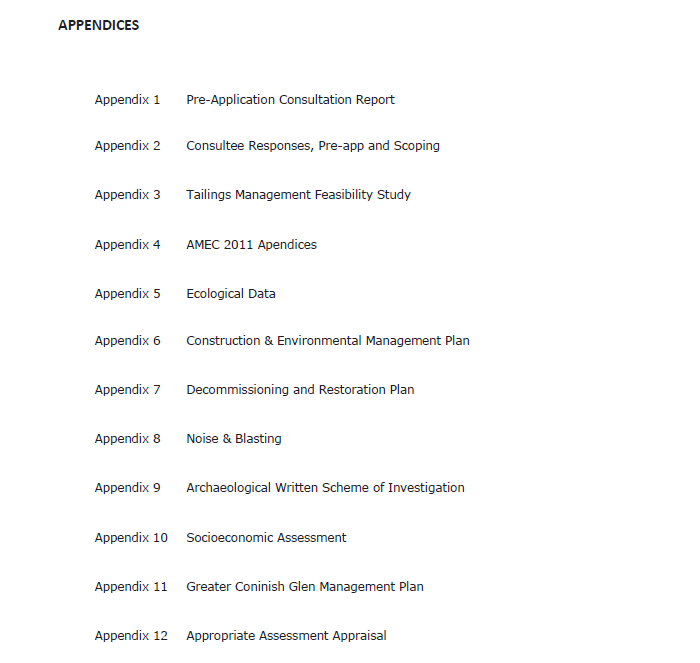
I have asked the LLTNPA to make these missing appendices public. There seems little point to the current emphasis the Scottish Government puts on open and transparent pre-consultation if that is not reported. I look forward to seeing the responses scotgold has made to the questions I and a friend made when we visited the consultation event at the village hall, which were all about how much more mine waste was going to be dumped on the hillside and the reasons for this.
What’s going on at Cononish shows is that there are major democratic deficits in our planning system. This suits Developers and, it appears, the LLTNPA, because it avoids planning proposals from being subject to external scrutiny. Its really important that the public demand that the Scottish Government address these failures in the forthcoming planning bill.
The main reasons why the new planning application must be refused by the LLTNPA
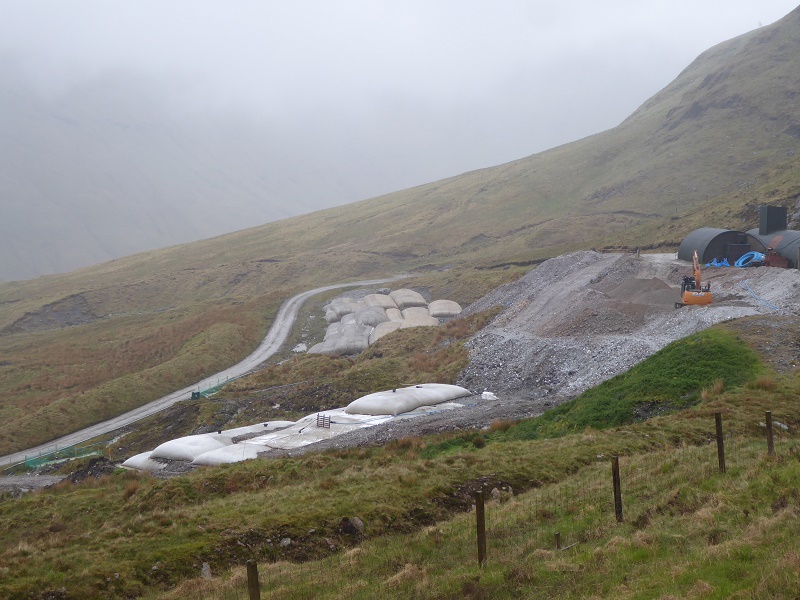
Scotgold already has planning permission for the gold mine, subject to certain conditions, and earlier this year Scotgold they were given an additional permission to start work on processing 8000 tonnes of former mine waste to extract gold. For the waste pictured above thas produced ten one ounce rounds which the press reported this week were auctioned for £46k, a mark up on nearly 400% over current market price. I will come back to how any of this can be considered sustainable economic development or sustainable use of resources in a future post.
Here I will focus on the two key differences from the earlier planning application. The first is that far more waste will be dumped outside of the mine. The original approval included the following conditions::
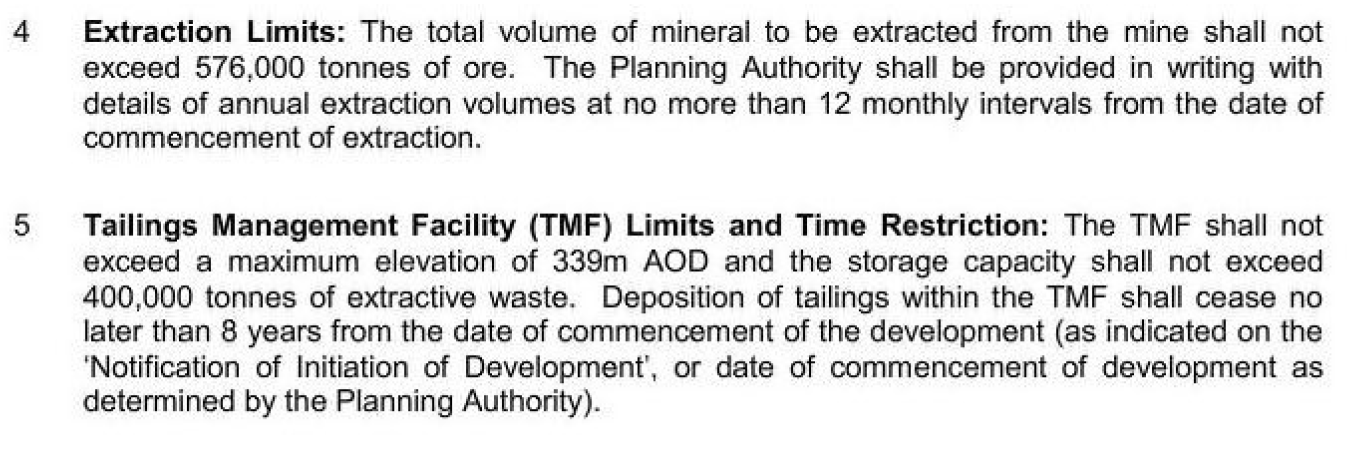 “REASON: To minimise the adverse landscape and visual impact and ensure that the site is restored to a satisfactory standard in this sensitive area of the National Park.”
“REASON: To minimise the adverse landscape and visual impact and ensure that the site is restored to a satisfactory standard in this sensitive area of the National Park.”
The key bit is under point 5, the amount of waste to be stored outside the mine was limited to 400,000 tonnes because of the sensitivity of the National Park. Since the original application, the areas of the gold mine has been included in the Ben Lui Wild Land area so any protection of that sensitivity should be even stronger than before.
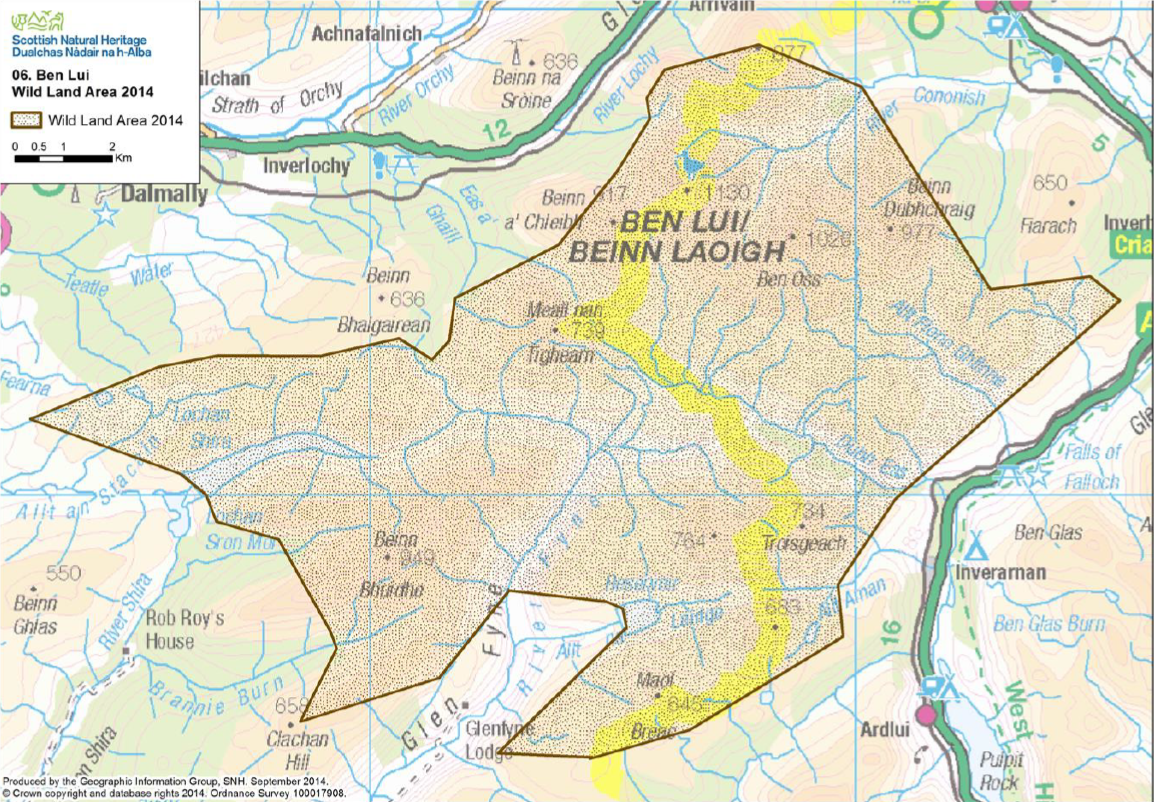
In my posts earlier this year, I drew attention to the fact that that amount of waste Scotgold wanted to dump outside the mine had increased to 530,000 tonnes of tailings. It now that this was a vast undersestimate and that in addition to this scotgold wants to dump another 170,000 tonnes of unprocessed rock waste outside the mine. That makes 700,000 tonnes of waste in all, a 75% increase in the amount of waste that is to dumped on the hillside outside the mine. Nowhere in the application is this enormous increase clearly stated. It appears no-one wants the public to know. One consequence, if this is approved, is that the waste is now going to be disposed over a far wider area than would be needed if it was limited to 400,000 tonnes as previously.
It appears money has driven this change. It would cost far more to replace waste back in the mine because the construction of tailings dams requires large up front capital investment. So the new plan is not only to avoid replacing waste back into the mountain, its to create 10 tailings stacks of approximately 72,0000 tonnes each. The second main difference to the earlier proposal. This represents one full year’s worth of waste if new mining machinery is installed, 6 months if its not. The stacks will be up to 10m high and moulded into shapes Scotgold claim will resemble moraine.
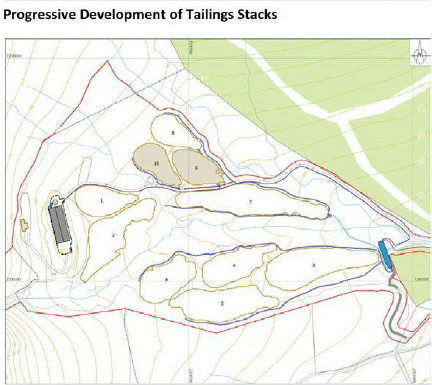
One of the interesting things about this is the current proposal is claimed to be much better in landscape terms than the last one – an admission that the tailings dam as approved would in fact have had an adverse impact on the landscape in a sensitive area (and therefore should have been refused by the LLTNPA!). This time though we are told there will be no adverse impact, even though almost twice the amount of mine waste is to be spread over the hillside. I am sceptical and so should the LLTNPA.
 The reason for this is that in order to extract the gold, the quartz ore need to be crushed until it becomes sand and it is this sand which will make up the bulk of the stacks. Now while you find sand in glacial moraine there is also lots of rock and finer particles – silt which goes to make clay – which helps bind the whole lot together. However, if you place sand onto what is a pretty wet hillside – it was sopping when I visited in May – it would all wash away which is no doubt why originally a tailings dam was proposed. Scotgold’s proposed solution to this – although storing sand is never acknoweldged as far as I can see to be a problem – is to use the rock waste which was to be left in the mine to line the ground, put a geo-textile on top of this and then mould the sand on top of that. Here are the design criteria:
The reason for this is that in order to extract the gold, the quartz ore need to be crushed until it becomes sand and it is this sand which will make up the bulk of the stacks. Now while you find sand in glacial moraine there is also lots of rock and finer particles – silt which goes to make clay – which helps bind the whole lot together. However, if you place sand onto what is a pretty wet hillside – it was sopping when I visited in May – it would all wash away which is no doubt why originally a tailings dam was proposed. Scotgold’s proposed solution to this – although storing sand is never acknoweldged as far as I can see to be a problem – is to use the rock waste which was to be left in the mine to line the ground, put a geo-textile on top of this and then mould the sand on top of that. Here are the design criteria:
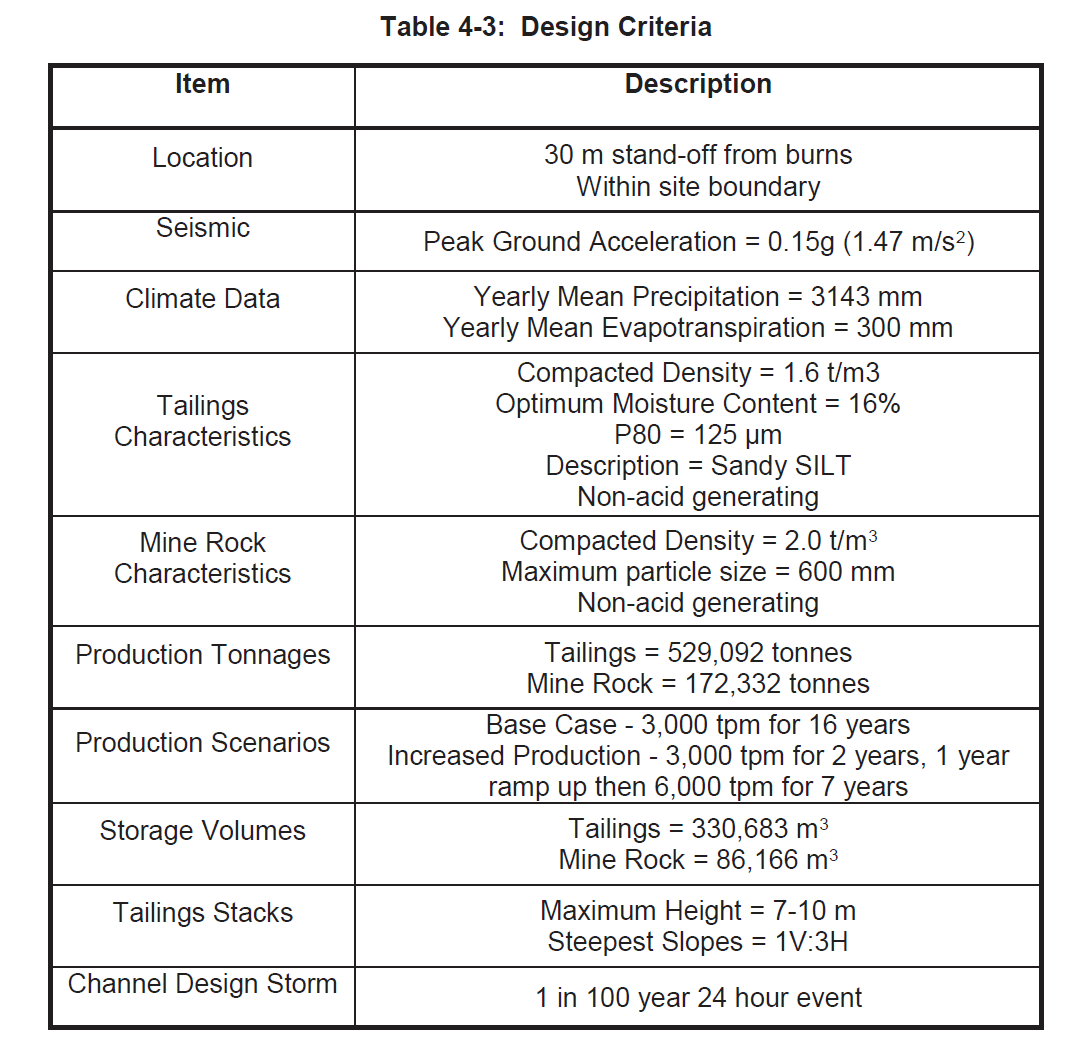
Now it doesn’t take an expert to see that there are potentially two major problems with this. The first is there is nowhere I can see that any consideration is given either to the life span of the membrane or what happens when it breaks down as it eventually must. A reasonable assumption is that when this happens the stacks of compressed sand will start to be eroded away from beneath. I suspect by then scotgold will have long gone leaving the public to pick up the tabs for preventing an environmental disaster.
The second is there is no proper consideration that I can see of whether it is possible to revegetate heaps of sand in the Scottish Hills in such a way that they will be able to withstand the erosive force of water from above or from the sides. The re-vegetation plan is to store turfs, up to 30 cm thick and then use them to cover the stacks. How well these will take on dried sand, which should drain quickly and is different in composition to current soils/peat is unclear. Cononish, as the chart helpfully shows, has over three metres of rain a year. Some of that may run off the top of vegetation but some of it will seep into the dried out sand heaps. What will that do? And even if the vegetation does take and provides a waterproof seal, what happens if deer get into the enclosure and start to erode tracks over the mounds? It seems to me there is a high and predictable risk of wash outs of the tailing stacks. And that’s without considering the risks of the Alt Anie changing course by more than the 30m safety zone or of other burns running between the stacks which could be subject to flash floods. That sort of scenario lead to catastrophic wash-outs.
I find it strange that neither SEPA nor SNH in their responses – and they have a duty to protect the River Tay Special Area of Conservation have asked critical questions about the risks associated with the current proposals or for evidence that the proposed techniques work in very wet climates such as Tyndrum. Perhaps they think its ok for 530,000 tonnes of sand potentially to wash into the river system over say the next 200 years? Smaller heaps, with less material as originally agreed, would of course reduce the size of this risk.
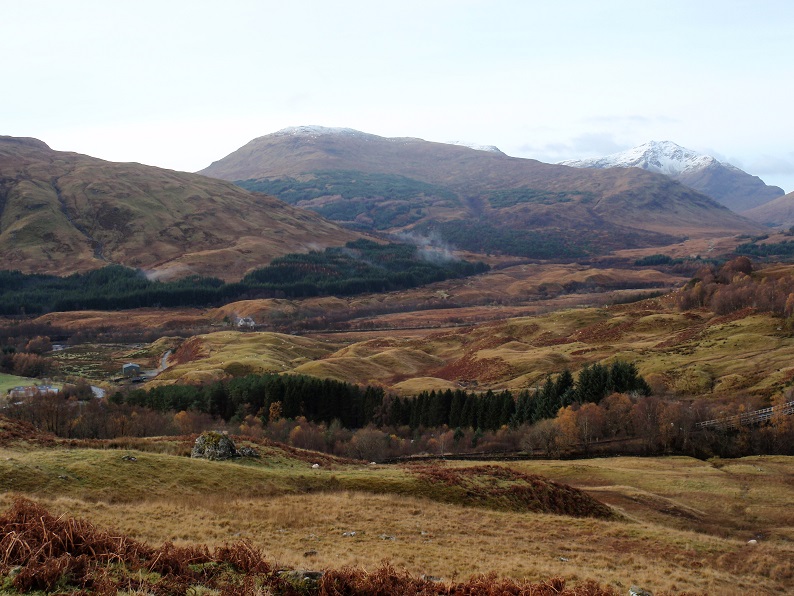
I am no expert on erosion risks and there is some technical documentation in the application which relates to this which needs to be explained in lay terms as well as properly scrutinised. However, from a scan of the documents – there are 100s of pages of engineering documentation – there is some information in the application which suggests storage of sand is problematic. This indicates there are high risks of sand sheering on slopes of more than 30 degrees. This is why the proposed stack heaps do not resemble natural moraine (for an example see above) but are to be moulded across the hillside.
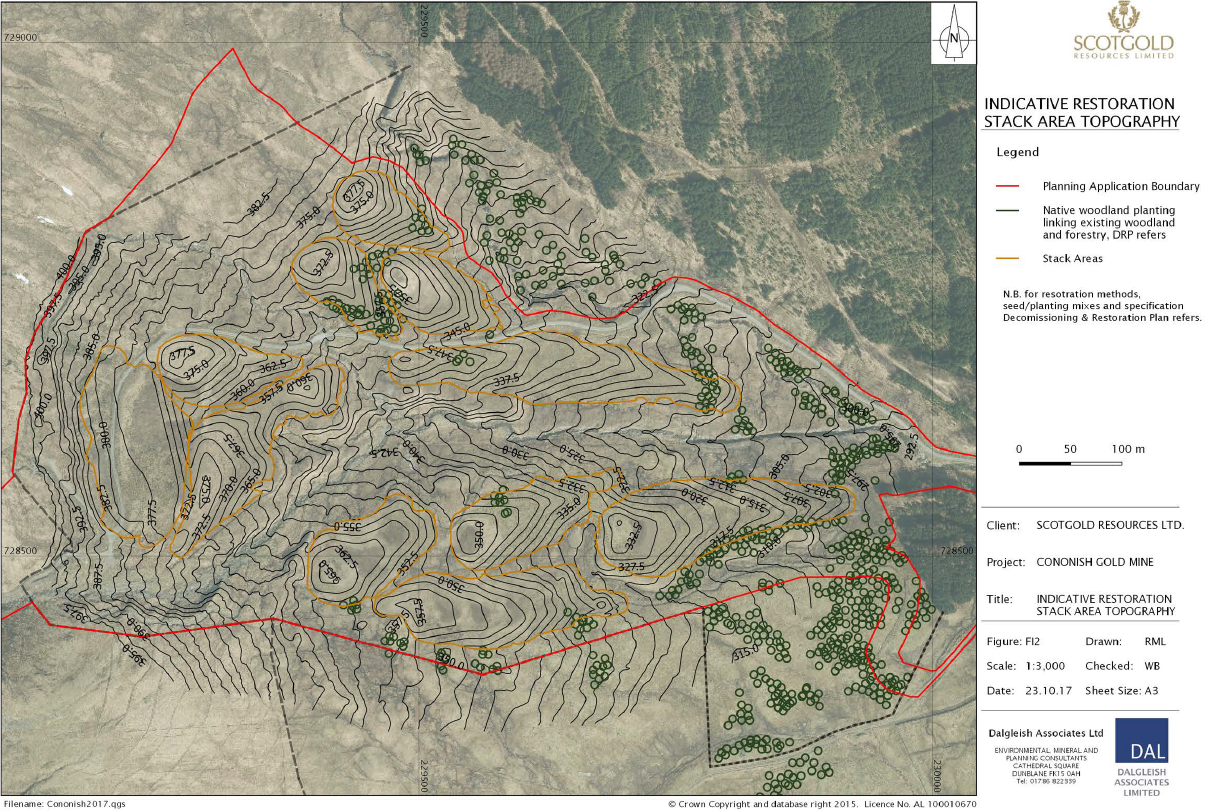
The Landscape impact of the tailings stacks
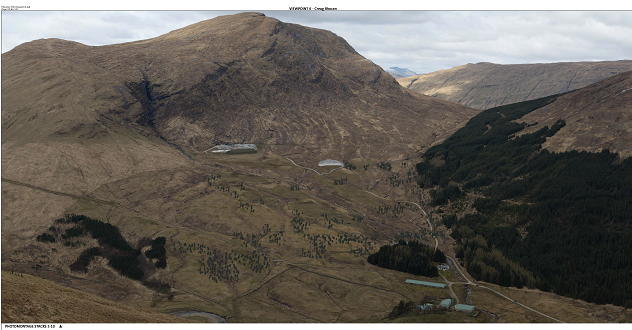
The Environmental Statement contains a number of visualisations of the landscape impact from different angles (see above). These without exception make the tailings stacks disappear into the hillside. Maybe they will, but there are reasons to be sceptical:
- All the visualisations are from a distance and none show what a 10m high stack will look like from close up either before or after restoration.
- The photos are all browns, a depiction of the area in winter. However, because the stacks will be well drained their vegetation is likely to be very different to the surrounding peaty slopes and therefore stand out from it. How this might look is unclear.
There are no depictions of how the sand heaps will look when they start to erode away as eventually they must.
The landscape impact of the buildings and spoil around the mine is not really covered but is already having a significant landscape impact. The assumption seems to be blots on the landscape, as long as developers can claim they are temporary (in this case it will be for over 20 years not for all time, are perfectly acceptable in our National Parks.
The wider implications of this application
Cononish is not the only potential goldmine in the area and scotgold, when trying to talk up its prospects to attract investors, claims there is potential for several other mines in the area. So what will the cumulative impact be of potentially millions of tonnes of mine waste sculpted onto hillsides around the Tyndrum and Glen Orchy hills?
What needs to happen
The LLTNPA needs to subject the new planning application to critical scrutiny and in particular make a clear statement about the sustainability or not of the tailings stacks.
If the erosion risks can be addressed, in terms of the existing planning permission, it might be better for 400,000 tonnes of waste to be stored in a stacks rather than in a tailings dam. However, the LLTNPA needs to draw a line under the amount of waste it will allow to be stored on the hillside and this should not exceed the existing limit.
The proposed use of geotextiles is interesting – as I understand it these are typically based on nylon/PVC or similar materials . The main problem with them seems to be their short lifespan. The ScotGold planning documents don’t say exactly what sort of geotextile is proposed – the only reference seems to be to geojute in some banking re-enforcement. This is (by design) biodegradable. Yet again you’re highlighting issues that demand an answer. Why aren’t the “professionals” doing this work? As with most of your posts, it would be great to hear the Park Authority’s reply to your comments…
Hi, myself and my partner have indeed been on both sides of the mine and it is a catastrophe waiting to happen I will list our worries about this outstanding landscape?
A.the consultation was a bit shrouded it was quite hard to find information on the planning
B.it took 170 people to sell our environment out
Co.for deep vein mining you don’t just get gold you get all really nice stuff too, uranium, lithium and another few nastiess
D.the settling pond is porous in nature it is designed to slowly let the waste pour back into the environment that sounds good for the river orchy as it is on that side of cononish
El.the toxicity levels are horrendous near any mine, no matter what they mine(look at cancer levels in miners)
F.scotgold is an aussie pensions and hedge fund, no money goes to Scotland
G.the hostility you will receive upon going close to the mine is to me quite funny but to others would be intimidating(west highland way is really close)
H.you can see the Tailings from benmore
I have a lot more to say and do on this matter, feel free to contact me
Cheers
Tony
Hi Tony,
A , Really , I found it very easy to access.
B, Is the environment really being sold out ? I think you should consider the alternative PP
C, lol , can you list these , as far as my research has confirmed to date I have found none of what you have mentioned.
D, The water will be re circulated and it will be monitored
E, In this case that is absolute nonsense.
F, Shows just how little you know about this company , there was less than 10% owned by aussies and most of that was transferred as part of a minimum pace sale .
G, I have always found the locals to be very friendly when visiting , guess that must just be either my approach or yours .
H, For the last 30 years you have been able to see the mine spoil and if the new proposal is not passed you will see a 734,000 ton Tailings Dam forever.
I have a lot more to say on this matter to , feel free to contact me
As a keen walker I have been past the mine many times when approaching the Bens from the Cononish side. I fail to see, at least from the path that the vast majority of people take, any major visual impact. Indeed, it is good to see the local economy being bolstered by proper, full time, all year round jobs rather than part time, low wage jobs based around tartan and tweed. The rural economy can not be preserved in aspic for the townies who want a day out in the country once in a while.
I agree with comments about the sign, so guess what, I ignored it. I went up to the mine and actually talked to the people who worked there. I did not feel intimidated and was made welcome. I was even given a tour around the mine, very interesting for those who want to find out more about the reality of a working mine rather than just complain about it.
A very interesting diversion en route to a great walk. A shame more people aren’t a bit more open minded and want to read about facts rather than highly selective and biased comments. Still, what do I know, I am just a hill walker who recognises the importance of life in the rural areas is far more important to those who live there than part time occasional weekend strollers.
Scotgold’s current application will in my view be far better than the current existing Planning permission they already have which allows for an unsightly 734,000 t Tailings dam which would be a blot on the land, I think Scotgold should be commended for their approach as many another miner would simply carry on regardless of the environment.
Nick you seem to be missing some important and very relevant information;
The existing tailings dam will hold 400,000 t but its total mass is 734,000t so the new proposal at 720,000 t is actually marginally smaller and not as you wrongly claim to be 75% larger. The tailing dam that actually has planning permission includes 130,000M3 wall made up of till and 37,000M3 waste rock which is equivalent 334,000t when you add this to the 400,000 t of tailings and you get 734,000 t which is clearly more than the 720,000 t being proposed and certainly not 75% more as your article wrongly says
I don’t think this is necessarily a cheaper way of treating the waste either as additional equipment and time are required in this current proposed application , yes the upfront cost of constructing the Dam is removed but the overall cost is still there . For example, an additional filter press has been added to the processing circuit and 10 stacks will take more time and money to be sculpted to match the topography of the landscape than it would to simply pump the entire lot into one big unsightly 734,000 t tailings dam that already has planning permission.
The Bulk Processing Trial which will by the end of December will have processed 7,000 t of rock and has demonstrated that the compacted “sand ” is shown to be effectively impermeable and is more like till than sand , the same till that would be used in the construction of the Dam and as such the risk of it being washed away doesn’t really exist . By the time the bags break down the till be well compacted and covered with vegetation which 3m of annual rainfall will keep more than moist .As for the picking up the tab as I understand it their is a bond for site restoration currently in place which increases before the work / volume starts and increases as it goes , so in the unlikely event that Scotgold walk away there will be money in place for restoration if in the unlikely event it is needed.
I would be more concerned at the visual and environmental impact of a 734,000 t Tailings Damn mass ( nothing temporary about that ) which I believe rises to a level of 334m than that of a 10m high sculpted mound designed to match the topography and glacial effect already in the glen. If this current proposal is refused then that 734,000 t Dam is what you will be getting , take a moment to think that one through.
Barry thanks very much for your comment and I appreciate you drawing attention to the size of the proposed tailings dam approved in the existing planning permission which was not mentioned in my post and is relevant to consideration of the landscape impact of the waste proposals. However, I was not comparing the size of the 10 tailings stacks to the size tailings dam as you claim, I was highlighting the fact that the proposal is to dump 75% more waste outside the mine than previously. You have partially confirmed that when you say glacial till, ie material from outside the mine, was to be used in constructing the tailings dam. Is it not the case that if the extra 130,000 tonne of processed ore was returned to the mine – as required in previous planning consent – then there then could be either fewer tailing or they could be reduced in size. Moreoever, if the waste is as solid as you claim, then why cannot it be placed straight onto the till covering the slope without the need to extract any rock waste from the mine?
Nick , lol, When you only read to reply you will never learn or understand.
Almost 6 months have passed since you attended the 2nd public consultation and in all that time you have learned nothing!
734,000 tons outside from existing planning permission
720,000 tons for new proposal .
What part of you being wrong in suggesting there is a 75% increase do you not understand ?
It is clear you have very little understanding of both the existing planning permission and new application and of mining in general.
Barry, the condition attached to the extant planning permission limiting waste that could be dumped outside the mine to 400,000 tonnes was quoted in my article. If that is wrong, please give me the reference to when the National Park changed that condition. Increasing the amount of waste that can be left outside the mine from 400,000 to 720,000 is over a 75% increase. It would be good if you could answer my question about why the dried tailings need to be placed on rock waste if they are as solid as you claimed.
Nick, As author of this article you have a responsibility to ensure you are publishing correct information which in this case you are clearly not.
It is not my job to supply you with information or to correct your poor and inaccurate and misleading article or do your research for you, that is your responsibility and your liability, while you may wish to troll through the National Parks website I don’t. You had ample opportunity at the public consultation to ask Scotgolds management and consultants anything you wanted when you attended back in May, had you any understanding of mining you might have learned something , that is if you wanted to!
Give this a thought Nick, ask yourself just where is that 130,000m3 of material coming from to build that Tailings Dam to hold that 400,000 t , has the penny dropped yet ? Could it be from mine Nick .
There is no increase in the amount of material being placed on surface there is actually a reduction Nick, that is a simple fact but that does not sit well with your article or your clear agenda.
Please do your own research and take your doom and gloom glasses off when doing so as they are blocking your judgement and effecting that of others but I believe that is your desire . Why let the truth get in the way of another doom and gloom story ?
Barry, I would be grateful if you could confirm whether or not you are employed in any way by Scotgold and if not how you have any information about what I did or did not say at the consultation event. Nick
Nick,
In answer to your question:
I am not employed by Scotgold in any shape or form.
I also attended the open day back in May and people do talk to each other, it is still permitted even in a National Park.
I would be grateful if you could answer the following :
Are you deliberately putting incorrect information on your blog / website ?
Are you being paid to do so ?
If so by whom ?
Why do you limit your research to supply only negative information?
When will you be correcting you false and misleading article ?
===========
This is about the one fact you have correct, there will be 400,000t stored in the TMF facility . Note the wording , “stored in the TMF”
What you have failed to take account of in your figures are the volume of materials required and already permitted for under the current planning permission :
A ,The Construction of the TMF embankment , you know that big wall that holds the 400,000t of tailings
B, The volume of material to be used for the formation of the embankment for the recirculation ponds
C, The volume of the material associated with the diversion of the Alt East Anie
The new proposals are not 75% larger they are actually marginally smaller , so there is no increase in the volume stored outside.
You are aware of A, B and C so why have you omitted the obvious from your article ?
Your article is inaccurate and based on false information.
Barry, thanks for clarifying you are not paid by Scotgold. I am not paid for anything I do that is concerned with parkswatchscotland. In terms of the debate about the size of the tailings stacks, the S75 Agreement put it very clearly: “The TMF capacity is set at 400,000 tonnes. The underground tailings storage capacity is 150,000 tonnes”. So, 400,000 tonnes of waste was to be left permanently outside the mine but Scotgold is now asking for that to increase to 720,000 tonnes. I have had a look through the current application again and cannot see ANY proposals for storing waste inside the mine. This fundamental change has not been made clear in any of the planning documents. Your argument appears to be this doesn’t matter because other material from outside the mine was to be used to create the tailings dam and the total mass of this was larger than the 10 tailings stacks. My point, leaving aside serious questions about the vulnerability of tailings stacks to erosion, is that the landscape impact would reduce significantly if the Park was to insist that some of the tailings was stored inside the mine again. I asked questions about this at the open event and do not recall getting a clear answer. Scotgold can can put us all out of our misery if they issued a clear description of how the current proposals differ from those formerly approved but if they don’t do this the public should expect that the LLTNPA do so. In a National Park we should expect as much waste as possible either to be returned to the mine or taken elsewhere (.e.g for construction work). Where I am in agreement with you that in principle avoiding having to divert the Eas Anie is a good thing – I don’t think we should be diverting burns in our National Parks – and that this and other elements of both applications involve shifting material which is not extractive waste. Again, it would be good if Scotgold could clearly set out how this compares now to previous applications.
Nick you agree, lol that’s a start.
There are 148 Documents attached to the first application so little wonder a lot on here are confused.
You have your view that says there is a 75% increase on materials to be stored outside the mine for the new proposals which is simply wrong, there is no increase at all.
Have a look at the existing fully permitted plan and tell me the new proposals are not better
http://eplanning.lochlomond-trossachs.org/OnlinePlanning/files/1DFB90EB5EF35CDB2F235F3B0E735363/pdf/2011_0166_MIN-Appendix_3_-_Drawing_107_TMF_GENERAL_ARRANGEMENT__012revP08_-65824.pdf
The area shaded in grey and named as Tailings Beech is for the 400,000t that the park says is the maximum ” tailings ” to be stored , where do you think all that other material for the areas shaded in green are coming from. TMF tailings embankment , circulation pond embankment , Alt East Anie diversions.
It is not Scotgold’s fault if you don’t understand anything about mining nor is it their fault if you care not to learn or understand. You have no evidence whatsoever to back up your claims of “what if”, the national parks own experts have looked at this new proposal as has Scotgolds expert consultants and then there is you who knows nothing about it at all.
If you were a horse you would be very thirsty
Barry, for it to be true there will be no increase in waste stored outside the mine as you claim, on top of the 400,000 tailings to be stored in the dam (which we agree on) in the previous application there would have had to have been 334,000 tonnes of rock waste extracted from the mine to come to your figure of 734,000 tonnes which you said is total size of tailings dam (without giving a reference for this). That would mean no material from outside the dam would be used in its construction when you have said material from Eas Anie diversion would have been included. On top of that would be the 150,000 tonnes of tailing stored in the mine.
It is now proposed to store 530,000 tonnes of tailings outside the mine, that is a 130,000 tonne increase on the previous application and not far off the amount which was previously to be stored in the mine. The question is about the amount of rock waste – its now proposed to use 170,000 of rock waste as base of the stacks. For what you claim to be true the amount of rock waste must have reduced from 334,000 tonnes to 170,000 tonnes. If you can produce evidence to back up your claims, please provide it. Meantime, I take the point that the previous application was unclear about the amount of rock waste to be extracted from the mine and if some was to be left outside the mine on top of the 400,000 tailings, my estimate for the total increase in waste was an overestimate. What this shows is the need for the LLTNPA and Scotgold to produce transparent figures.
Nick,
You couldn’t make it up, oh wait you actually are !
On several occasions now I have told you it is not my job to correct your sloppy journalism. You asked me to prove my point , I ask you to disprove it after all you wrote the article, you go and troll through the 148 documents or just call the NP and ask , I am sure they would take great pleasure in telling you , that is if they take your calls !
Just where do you think all that material is coming from for the tailings dam embankment and the recirculation pond and the Alt East Anie diversion. The NP have very strict traffic restrictions in place so it won’t be being delivered .
Your knowledge of mining is none existent as is your knowledge of this project and the already existing permission and that is a fact.
Mr Chapman may not be employed by Scotgold, but I believe that he does have a financial interest in the planning application being successful. Perhaps he should be open about that.
I have not looked at the planning application myself so I do not know the rights and wrongs of the various tonnages mentioned. So I express no view either way on that. But I do have plenty of experience in property development. Almost certainly what is happening here is that Scotgold is looking to reduce the capital costs of extraction and therefore increase potential for profit. Chipping away at planning consents is not uncommon. That is not necessarily a problem – it depends upon the consequences and Mr Chapman’s focus on tonnage rather deflects from the overall picture.
The question to my mind is whether or not the altered approach will improve the environmental position from that which would arise from the current planning consent and, if I am right about the cost savings, what (financial) benefits the local community and the Park more widely will obtain from permitting the change.
Some legitimate concerns seem to have been raised and not addressed – e.g. the question of the use of geotextiles and, more importantly in my view, the landscape impact of the long term storage in the form of “moraine”. Also, if true, Scotgold’s failure to honour a commitment to consult with Mountaineering Scotland before submitting the application hardly shows transparency.
The other concern I would have relates to Scotgold’s planning commitments. In other words, what happens if Scotgold fails to undertake any required remediation or restoration works? Does the planning authority have the capacity (including expertise) to monitor activities in what may be a complex operation? Similarly bonding arrangements for restoration works can be inadequate. Better is a combination of bond and the establishment of a sinking fund by the developer together with regular re-assessments of the likely costs of restoration.
Before anyone asks, I am not connected with parkswatchscotland, Scotgold or the local community nor am I being paid or otherwise compensated by anyone connected to the planning application. I have climbed Ben Lui though so I know the area.
Francis,
Well done in climbing Ben Lui , I have done so on several occasions and I have also spent a considerable amount of time in the glen and at the mine. Yes your research into my personal life will reveal I have a holding in Scotgold , I would have thought though that facts and not fiction are more relevant than my financial affairs . Has anyone else , lol ? Or do they on that side of the fence not have to answer or prove anything, just merely suggest it might happen ,make up none existent increases, no proof required and you all believe it ?
It is not my fault I have considerable more knowledge on mining than Nick, nor is it my fault he is wrong by a country mile , nor is it my fault he doesn’t ask the relevant questions or look in the right place for answers as that clearly wouldn’t suit his agenda.
There is many a condition attached to Scotgolds existing planning permission and bonds and restoration works are very extensively covered.
There is something that should be taken into account and that is that this project is already fully permitted for the below and that the project has an unprecedented backing from the local community :http://eplanning.lochlomond-trossachs.org/OnlinePlanning/files/1DFB90EB5EF35CDB2F235F3B0E735363/pdf/2011_0166_MIN-Appendix_3_-_Drawing_107_TMF_GENERAL_ARRANGEMENT__012revP08_-65824.pdf
As for Mountaineering Scotland , if they were that worried they could have attended the open public consultation days instead of just relying on an obviously bad source of information from a friend who by his own words is no expert.
PS: Nick it’s nice to see that you now accept that the fully permitted Tailings Dam is not temporary as you so wrongly referred to as before .
In the interest of transparency, the real name of “Barry Chapman” is Graham Donaldson – a builder from Christchurch in Dorset who owns over 3% of the Cononish mine:
https://www.scotgoldresources.com.au/investor-centre/capital-structure/
Under a variety of aliases, he is a frequent contributor on the topic of Scotgold in several investing chat rooms and he also posts on Twitter as @GrahamScotgold.
Based on his disinformative writings in various places, and his habitual unwillingness to support his claims with verifiable quoted references, he seems to be more of a self-serving stock promoter than a local with any concern or responsibility for the environment or the amenities of the National Park.
Well, cite *your* sources! (RE: “unwillingness to support his claims with verifiable quoted references”)
Anon, lol
How I wish I had enough money to do so.
Regards
Barry , lol
Hi Nick,
My name is Simon Jonathan Chapman , I am not a local far from it I reside in Berkshire RG10 9XD and the last time I visited Scotland was a long time ago but I feel that I must correct you in as much as you are very wrong on your Scotgold article. I am an avid supporter of Scotgold and their CEO officer . I believe their efforts to ensure the countryside that we all love is properly protected is above and beyond the call of duty of a miner , any other miner would not show such care . The simple fact that the entire community is behind this company and the project shows the care that Scotgold have gone to , sure they have made mistakes as everyone does but when they have made mistakes they rectify them , shame you don’t have the same principles or morals .
Yeah preacher man ,this little old homestead needs gold just like hills need a flattening heh and once we’ve flattened them hell we can dredge thum clogged up streams and rectify them
Nick, does Scotgold’s formal response to your objections allay your concerns?